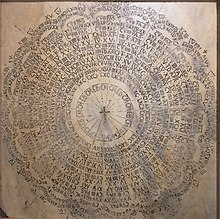
Back حساب عيد الفصح المسيحي Arabic Cálculu de la fecha de Pascua AST Računanje datuma Uskrsa BS Computus Catalan Computus CEB Výpočet data Velikonoc Czech Computus Danish Computus (Osterrechnung) German Ορθόδοξο Πασχάλιο Greek Kalkulo de la dato de Pasko Esperanto

As a moveable feast,[1][2] the date of Easter is determined in each year through a calculation known as computus paschalis (Latin for 'computation') – often simply Computus – or as paschalion particularly in the Orthodox church.[3] Easter is celebrated on the first Sunday after the Paschal full moon (a mathematical approximation of the first astronomical full moon, on or after 21 March – itself a fixed approximation of the March equinox). Determining this date in advance requires a correlation between the lunar months and the solar year, while also accounting for the month, date, and weekday of the Julian or Gregorian calendar.[4] The complexity of the algorithm arises because of the desire to associate the date of Easter with the date of the Jewish feast of Passover which, Christians believe, is when Jesus was crucified.[5]
It was originally feasible for the entire Christian Church to receive the date of Easter each year through an annual announcement by the pope. By the early third century, however, communications in the Roman Empire had deteriorated to the point that the church put great value in a system that would allow the clergy to determine the date for themselves, independently yet consistently.[6] Additionally, the church wished to eliminate dependencies on the Hebrew calendar, by deriving the date for Easter directly from the March equinox.[7]
In The Reckoning of Time (725), Bede uses computus as a general term for any sort of calculation, although he refers to the Easter cycles of Theophilus as a "Paschal computus." By the end of the 8th century, computus came to refer specifically to the calculation of time.[8] The calculations produce different results depending on whether the Julian calendar or the Gregorian calendar is used. For this reason, the Catholic Church and Protestant churches (which follow the Gregorian calendar) celebrate Easter on a different date from that of the Eastern and Oriental Orthodoxy (which follow the Julian calendar). It was the drift of 21 March from the observed equinox that led to the Gregorian reform of the calendar, to bring them back into line.